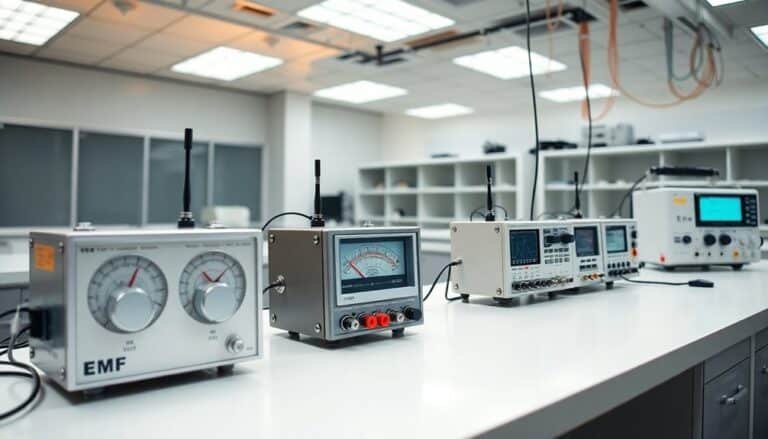When to Worry About EMF Exposure
Be concerned about EMF exposure if you frequently encounter high levels from sources like power lines, cell phones, or Wi-Fi networks, as symptoms such as fatigue, headaches, or cognitive issues may arise, particularly in vulnerable groups like children. Although regulatory limits aim to ensure safety, consistent high exposure could still pose risks.
Understanding how EMF impacts health is crucial, so consider learning about proactive measures to minimize exposure and protect your well-being.
Disclaimer: As an affiliate, I may collect a share of sales from the links on this page.
Understanding EMF: Definitions and Sources

When you explore the concept of electromagnetic fields (EMFs), it’s essential to grasp their foundational elements. EMFs are physical fields generated by electric charges, affecting surroundings. They consist of electric and magnetic fields that interact, creating propagating electromagnetic waves. These fields are known for their non-ionizing radiation, found in both natural and artificial sources. Natural sources include Earth’s magnetic field and cosmic radiation, while artificial sources derive from devices like smartphones, power lines, and Wi-Fi systems. Your daily activities can contribute considerably to EMF exposure, especially in urban environments with advanced technology, consequently increasing your interaction with these fields. Understanding that the interaction of charges and currents with the EM field is fundamental to recognizing how EMFs impact our lives. Additionally, common sources of EMF radiation, such as smartphones and mobile devices, play a significant role in everyday exposure.
Health Effects of EMF Exposure
Understanding the health effects of electromagnetic field (EMF) exposure requires careful examination of various symptoms and scientific findings.
Commonly reported effects include fatigue and headaches, alongside cognitive impairment and decreased learning potential. Some studies link EMF exposure to heightened anxiety and stress levels. Additionally, electromagnetic induction can also contribute to the complexity of health outcomes related to EMF exposure.
Furthermore, EMF can induce oxidative stress in tissues, impacting antioxidant levels in your body, which may affect your overall quality of life. This oxidative stress is associated with increased free radical production in biological tissues, further complicating health outcomes.
Importantly, children’s nervous systems are more vulnerable to these effects. Though research continues, there’s currently no clear causal evidence linking EMF exposure to specific health outcomes, leading to ongoing public concerns and scientific investigations.
The Link Between EMF and Cancer

Concerns about the health effects of electromagnetic fields (EMFs) extend beyond general well-being and into the domain of serious diseases, including cancer. The International Agency for Research on Cancer (IARC) classifies ELF magnetic fields as “possibly carcinogenic to humans.” Current research shows mixed results on links between EMF exposure and cancers like leukemia and breast cancer. Some studies point to changes in cellular processes, such as gene expression and oxidative stress, which may contribute to cancer. However, definitive conclusions remain elusive due to inconsistent findings and ongoing research challenges in this area. Additionally, epidemiological studies have demonstrated that most studies on EMF and cancer lack critical factors that support causation.
Regulatory Standards for EMF Safety
Regulatory standards for electromagnetic field (EMF) safety provide essential frameworks to protect public health and guarantee compliance across various industries.
Internationally, guidelines from the International Commission on Non-Ionizing Radiation Protection (ICNIRP) and International Committee for Electromagnetic Safety (ICES) establish exposure limits. For magnetic fields, ICNIRP sets limits at 2,000 mG, while ICES suggests higher values, like 9,040 mG.
In the U.S., the Federal Communications Commission (FCC) regulates RF exposure. Industries must comply with local and international EMF standards, ensuring workplace safety. Additionally, welding processes are recognized as high-risk occupations due to their potential EMF exposure, emphasizing the need for strict adherence to safety regulations.
Continuous research supports these standards, with organizations like the Electric Power Research Institute actively contributing to safety data.
Vulnerable Populations and EMF Exposure

Vulnerable populations, particularly children, face heightened risks from electromagnetic field (EMF) exposure due to their developing bodies and increased sensitivity.
Children’s brains are actively developing, making them more susceptible to electromagnetic radiation’s potential effects. Recent studies indicate a small, but concerning, link between low-frequency magnetic fields and childhood leukemia.
Factors contributing to exposure include proximity to power lines and frequent use of electronic devices.
As public awareness grows, caregivers increasingly recognize the importance of minimizing EMF exposure. Following health guidelines, like staying away from high-voltage power lines and limiting device usage, can help protect these vulnerable individuals from potential risks.
Recognizing High Exposure Levels
How can you identify high levels of electromagnetic field (EMF) exposure in your environment?
Start by checking if you’re close to EMF sources, like antennas or transmission lines.
Use specialized instruments, such as EMF meters, to measure electric and magnetic field strengths.
Familiarize yourself with safety codes, like those from Health Canada, which outline limits for RF exposure.
Pay attention to workplace environments, especially in telecommunications, where occupational exposure can increase risks.
Monitor your exposure over time, noting cumulative effects from multiple sources.
Recognizing these factors helps you determine whether you might be experiencing high EMF exposure levels.
The Role of Ionizing Radiation
While ionizing radiation plays a significant role in various fields, its potential health risks warrant careful consideration. This type of radiation possesses enough energy to break chemical bonds, which can alter molecular structures and lead to DNA damage. Common examples include X-rays and gamma rays.
High doses can cause immediate symptoms like burns and long-term effects such as increased cancer risk. Vulnerable groups, like developing fetuses and immunocompromised individuals, face greater risks.
While medical applications, such as imaging and cancer treatment, offer benefits, the dose-response relationship emphasizes that higher exposure correlates with heightened health risks.
Proactive Measures for Reducing EMF Exposure
As awareness of the health risks associated with exposure to electromagnetic fields (EMFs) grows, individuals and organizations alike are seeking effective strategies to mitigate these risks.
Start by keeping a safe distance from EMF sources; it markedly reduces exposure. Design workspaces to place devices away from employees, and limit exposure duration through policy.
Use shielding materials like EMF-blocking fabrics or Faraday cages to shield against harmful emissions. Create device-free zones and manage appliance use; unplugging items when not in use lowers EMF levels.
Finally, consider wired connections over Wi-Fi to minimize radiofrequency exposure in your environment.
Frequently Asked Questions
How Can I Measure My Home’s EMF Levels?
You can measure your home’s EMF levels by selecting a suitable meter, calibrating it, and taking readings in different areas. Compare those readings to safety limits, then apply mitigation strategies if necessary to reduce exposure.
Are There Specific Appliances That Emit More EMF?
You might be surprised to learn that certain appliances emit significant EMF levels. Microwaves, laptops, and hair dryers are among the top offenders, especially when you’re close. Stay informed about your exposure to protect your health.
What Distance Reduces EMF Exposure From Devices?
To reduce EMF exposure, keep devices at least one foot away from your body. Use tables for laptops and maintain distance from wireless devices like routers. A little distance goes a long way in minimizing your exposure.
Can EMF Exposure Affect Pets or Animals?
Yes, EMF exposure can affect pets and animals. You’ll notice potential changes in behavior, reproduction, and health. Different species react variably, so staying informed about their specific needs and the environment is essential for their well-being.
Are There Apps to Track EMF Exposure in Real-Time?
Ever wondered how you can keep an eye on those invisible waves? You can easily track EMF exposure in real-time using various apps. Check out options like Ultimate EMF Detector for a deeper understanding!
Conclusion
It’s important to monitor your exposure to electromagnetic fields (EMFs), as nearly 50% of Americans live close to cell towers. While most EMF exposure is considered safe, high levels can be concerning for vulnerable groups like children and pregnant women. Taking practical steps, such as reducing contact with EMF sources, can help mitigate potential health risks. Stay informed to make informed decisions about EMF safety.






